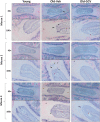Systemic clearance of p16INK4a -positive senescent cells mitigates age-associated intervertebral disc degeneration
- PMID: 30900385
- PMCID: PMC6516165
- DOI: 10.1111/acel.12927
Systemic clearance of p16INK4a -positive senescent cells mitigates age-associated intervertebral disc degeneration
Abstract
Rationale: Age-related changes in the intervertebral discs are the predominant contributors to back pain, a common physical and functional impairment experienced by older persons. Cellular senescence, a process wherein cells undergo growth arrest and chronically secrete numerous inflammatory molecules and proteases, has been reported to cause decline in the health and function of multiple tissues with age. Although senescent cells have been reported to increase in intervertebral degeneration (IDD), it is not known whether they are causative in age-related IDD.
Objective: The study aimed to elucidate whether a causal relationship exists between cellular senescence and age-related IDD.
Methods and results: To examine the impact of senescent cells on age-associated IDD, we used p16-3MR transgenic mice, which enables the selective removal of p16Ink4a -positive senescent cells by the drug ganciclovir. Disc cellularity, aggrecan content and fragmentation alongside expression of inflammatory cytokine (IL-6) and matrix proteases (ADAMTS4 and MMP13) in discs of p16-3MR mice treated with GCV and untreated controls were assessed. In aged mice, reducing the per cent of senescent cells decreased disc aggrecan proteolytic degradation and increased overall proteoglycan matrix content along with improved histological disc features. Additionally, reduction of senescent cells lowered the levels of MMP13, which is purported to promote disc degenerative changes during aging.
Conclusions: The findings of this study suggest that systemic reduction in the number of senescent cells ameliorates multiple age-associated changes within the disc tissue. Cellular senescence could therefore serve as a therapeutic target to restore the health of disc tissue that deteriorates with age.
Keywords: aggrecanolysis; aging; cellular senescence; intervertebral disc; p16Ink4a; proteoglycan.
© 2019 The Authors. Aging Cell published by the Anatomical Society and John Wiley & Sons Ltd.
Conflict of interest statement
None declared.
Figures





References
-
- Alvarez‐Garcia, O. , Matsuzaki, T. , Olmer, M. , Masuda, K. , & Lotz, M. K. (2017). Age‐related reduction in the expression of FOXO transcription factors and correlations with intervertebral disc degeneration. Journal of Orthopaedic Research: Official Publication of the Orthopaedic Research Society, 35, 2682–2691. - PMC - PubMed
Publication types
MeSH terms
Substances
Grants and funding
LinkOut - more resources
Full Text Sources
Other Literature Sources

